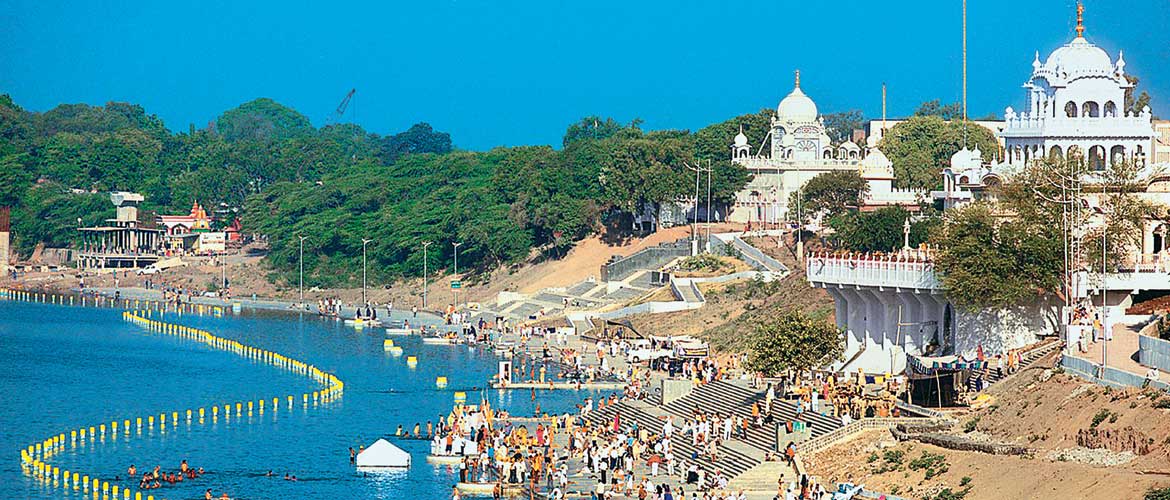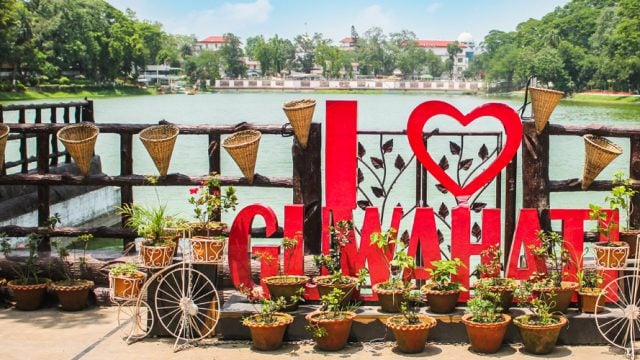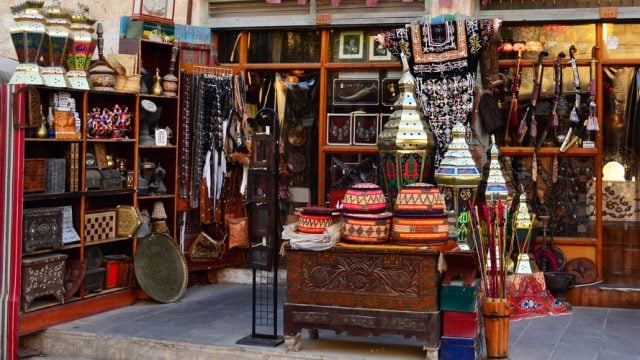At first glance Nanded looks like any other city in the region of Marathwada, with
Today, Nanded is a crucial centre in Maharashtra’s political map, a regional education hub and renowned for its health-care facilities.
HISTORY
The Nanda dynasty, which held fort in Magadha, ruled over Nanded during the 5th and 4th centuries BCE until Chandragupta Maurya defeated Dhana Nanda in 322 BCE. Following this, Nanded was under the rule of the Mauryan Empire. After the Mauryas, the Satavahanas ruled Nanded in the first century CE.
Leela Charitra, a treatise written by Mhaimbhatta about 700 years ago, mentions Nanded and its irrigation practices. According to a copper plate inscription found at Vasim, Nanded was previously known as Nanditat. It is said that Lord Shiva once performed a penance on the tat (banks) of the Godavari river, and hence, the place came to be known as Nanditat. (Nandi is Shiva’s vahana or vehicle). The name Nanditat eventually evolved into Nanded.
This area was under the rule of the Chalukya king Nanda Deva during the 4th century CE. The Chalukyas left a great impression in Nanded and the adjoining areas with their architecture. The Siddheshwar temple in Hottal (around Nanded), made of stone, stands as a classic example of Chalukyan art and architecture.

Much later, the first Guru of Sikhism, Guru Nanak Dev, supposedly crossed Nanded on one of his tours. The tenth apostle, Guru Gobind Singh moved to Nanded in 1708 and lived here during the final years of his life. Here, he declared that he would be the last guru of Sikhism and passed on the mantle to Guru Grant Sahib (the holy book of Sikhism). Nanded houses many gurudwaras including the Hazur Sahib Gurudwara, which is one of the Panj Takhts (five seats of authority) of Sikhism.
After 1725, Nanded became a part of the Hyderabad state under the Nizams until the Indian Army annexed the state post Independence.
ORIENTATION
Being the second largest city in Marathwada (after Aurangabad), Nanded comes with its share of chaos in the form of busy, dusty roads and rapid economic growth. The city is practically divided into two parts with the Godavari river flowing in between. The Nanded District shares its border on the West with a few other Marathwada districts – Latur, Yavatmal and Parbhani – and on its East is the newly formed state of Telangana. Nanded is well connected by road to other major towns and cities in Maharashtra. A few dozen trains ply to the town from all major cities in India, every day. However, the airport in the city is currently not operational. In Nanded, there are buses to take pilgrims and tourists from one place to another. Hiring a local taxi is also a safe and comfortable way to get around the city.
THINGS TO SEE AND DO
Nanded is one of the most popular destinations for Sikh pilgrims from across the country. The city is home to numerous gurudwaras, all of which hold some historical importance to Sikhs.

The city, and its surrounding areas, are also marked by monuments built in typical Dravidian style architecture built by the Chalukyas and the Rashtrakutas who ruled Nanded from the fourth century CE to the 11th century CE.
Hazur Sahib
The Hazur Sahib Gurudwara stands over the site where the tenth and last Sikh Guru Guru Gobind Singh had been cremated. The Angitha Sahib, the inner room of the Gurudwara, marks the exact site. Before his death in 1708, Guru Gobind Singh held his court and congregation here.
Built by Maharaja Ranjit Singh of Punjab, between 1832 and 1837, the Gurudwara is considered the second holiest place for Sikhs, after the Harmandir Sahib (Golden Temple) in Amritsar. It is part of the Panj Takhts of Sikkhism, which include Harmandir Sahib, Akal Sahib (in the premises of the Golden Temple), Damdama Sahib (near Bhatinda, Punjab), Keshgarh Sahib (Anandpur, Punjab) and Patna Sahib (Patna, Bihar). Looking majestic in white and gold, the Hazur Sahib imparts a sense of inner peace with its serene atmosphere and hospitable people. It is also a perfect place to sit down and meditate for a few minutes. Like most other gurudwaras, the Hazur Sahib also offers langar (canteen/kitchen where food is served to all, for free) to all the pilgrims and visitors.
Nanded Fort
The Nanded Fort is at a distance of 4 km from the Nanded Railway station. With the Godavari River surrounding it on three sides, the fort stands at a picturesque location with sprawling gardens around it.
However, most of the fort is in ruins, owing to repeated conquests of the Mughals on Marathwada. One can reach the fort by hiring an auto in the city.
WHERE TO STAY AND EAT
There are many hotels to stay, in Nanded. Hotel City Pride (Tel: 02462-222232, Cell: 08805012388; Tariff: ₹3,000–7,200), near the airport, has a restaurant, bar and Internet services. Anuradha Palace (Tel: 232021-22, 241141; Tariff: ₹880– 3,650) on Station Road offers a restaurant and room service. Hotel Chandralok (Tel: 224000-01, 220430; Tariff: ₹1,776–4,141) is on Old Airport Road and Hotel Bajaj Residency (Tel: 690915, Cell: 09422149206, 09960869146; Tariff: ₹1,400–7,000) on Purna Road. are good options.
Besides the hotels, there is plenty of comfortable accommodation provided by the Hazur Sahib Gurudwara (Tel: 243559) and other gurudwaras in Nanded. Their newly constructed NRI Yatri Niwas (Tel: 234902; Tariff: ₹250–500) provides AC and non-AC rooms.
Apart from the restaurants at the hotels, Nanded doesn’t have many big restaurants. Gokul and Om restaurants serve good vegetarian food. Colours has good ambience and serves vegetarian and non-vegetarian fare. So does Sunder Dhaba. Godavari Bar & Restaurant is a great place to unwind and relax over good food and drinks. Shri Krishna Vilas, an old joint, serves a variety of paranthas. For Mahashtrian thalis, head to Rasoi. Hazur Sahib Gurudwara and Gurudwara Langer Sahib provide free langar everyday.
AROUND NANDED
Kandhar Fort (44 km)
Although in ruins, the Kandhar Fort is comparatively in a better condition than the Nanded Fort. It is in Kandhar village, at a distance of 44 km from Nanded city, and is marked by the distinctive Dravidian style of architecture. Rashtrakuta King Krishna III commissioned the fort sometime between the 6th and the 10th centuries CE. Repeated attempts to conquer the fort by the Mughals have left it in a derelict state. Surrounded by water on three sides, it stands in a scenic location and can be reached from Nanded by a taxi.
Siddhershwar Mandir Hottal (105 km)
A Chalukyan era monument dedicated to Lord Siddheshwar, this 11th century CE temple lies in a small village called Hottal, in the Degloor Taluka of Nanded District. Like other Chalukyan monuments, the temple is made out of stone, with intricately carved sculptures along its walls.
Shrikshetra Mahurgadh (98 km)
A temple dedicated to Renuka Devi, Shrikshetra Mahurgadh is situated on a hill near Mahur village in Nanded District. The temple is one of the three shaktipeeths located in Maharashtra. It receives pilgrims from surrounding areas and a few districts of Telangana as Renuka Devi is an important local deity. Situated at a distance of 98 km from Nanded, it can be reached by hiring a taxi.
|
FAST FACTS |
|
When to go The winter season |
|
Tourist Office |
|
MTDC |
|
MTDC Holiday Resort |
|
GETTING THERE |
|
Region Marathwada Location In the southwestern part of Maharashtra, bordering Telangana Distance 264 km S of Aurangabad Route from Aurangabad Via Jalna-Jintur Road Air Nanded Airport, currently not operational. Nearest airport is Aurangabad (250 km/ 5 hrs). Taxi costs about ₹4,000 |
|
Rail Nanded Railway Station has direct train connectivity with Mumbai, Delhi, Pune, Bengaluru, Kolkata, Amritsar, Bhopal, Indore, Agra, Hyderabad, Jaipur, Ajmer, Aurangabad, Nashik among other cities in India |
|
Road Nanded has a good network of national and state highways connecting it to other parts of the state and neighbouring states. NH204, NH222 and NH161 pass through the city. |
|
Bus ST and private buses from all major cities in the state have regular services to Nanded |
Godavari river
Gurdwara Hazur Sahib
heritage





